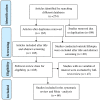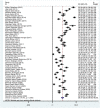Prevalence and predictors of anemia among pregnant women in Ethiopia: Systematic review and meta-analysis
- PMID: 35895619
- PMCID: PMC9328503
- DOI: 10.1371/journal.pone.0267005
Prevalence and predictors of anemia among pregnant women in Ethiopia: Systematic review and meta-analysis
Abstract
Background: In Ethiopia limited information is available regarding the prevalence and predictors of anemia in pregnancy. This systematic review and meta-analysis estimated the pooled prevalence of anemia among pregnant women in Ethiopia and also identified its predictors.
Materials and methods: The published primary studies were searched in the following electronic databases; PubMed/Medline, Google scholars, AJOL, and EMBASE. All primary studies published from 01/01/2010 to 30/05/2020 and written in English language were included without restriction on study setting and design. Critical appraisal of all available articles was done and extracted data was analyzed using STATA software version 14. The pooled prevalence of anemia was presented using a forest plot. The I2 statistical test for heterogeneity, and the Egger's and Begg's tests for publication bias were used. The relative risk was used to assess the association of predictor variables with anemia.
Result: After screening 274 articles, sixty studies were included in the analysis. The pooled prevalence of anemia among pregnant women was 26.4(95% CI: 23.1, 29.6). Sub-group analysis showed higher pooled prevalence from community-based studies than institutional-based studies. Factors that were protective against maternal anemia included urban residence, formal education and smaller family size. Short birth interval and not having antenatal care (ANC) are associated with a higher risk of maternal anemia. Women with low dietary diversity [RR: 2.61(95% CI, 1.85, 3.68)], mid-upper arm circumference (MUAC) less than 23 cm [RR: 2.35(95% CI, 1.53, 3.68)] and those not taking iron-folic acid [RR: 1.53(95% CI: 1.30, 1.81)] also had a higher risk of anemia.
Conclusion: Almost one in four pregnant women in Ethiopia had anemia. Being literate, living in urban areas with small family size and adequate birth spacing, as well as good dietary diversity are associated with a lower risk of anemia in pregnancy.
Registration number: (ID: CRD42020211054).
Conflict of interest statement
The authors have declared that no competing interests exist.
Figures





Similar articles
-
Adherence to iron-folic acid supplementation among pregnant women in Ethiopia: a systematic review and meta-analysis.BMC Pregnancy Childbirth. 2020 Mar 4;20(1):138. doi: 10.1186/s12884-020-2835-0. BMC Pregnancy Childbirth. 2020. PMID: 32131751 Free PMC article.
-
Adherence of iron and folic acid supplementation and determinants among pregnant women in Ethiopia: a systematic review and meta-analysis.Reprod Health. 2019 Dec 21;16(1):182. doi: 10.1186/s12978-019-0848-9. Reprod Health. 2019. PMID: 31864397 Free PMC article.
-
Prevalence and determinants of anemia among pregnant women in Ethiopia; a systematic review and meta-analysis.BMC Hematol. 2017 Oct 17;17:17. doi: 10.1186/s12878-017-0090-z. eCollection 2017. BMC Hematol. 2017. PMID: 29075500 Free PMC article.
-
Intention to use maternal waiting home and its predictors among pregnant women in Ethiopia: systematic review and meta-analysis.Eur J Med Res. 2023 Aug 7;28(1):274. doi: 10.1186/s40001-023-01248-7. Eur J Med Res. 2023. PMID: 37550705 Free PMC article. Review.
-
Magnitude of postpartum hemorrhage and associated factors among women who gave birth in Ethiopia: a systematic review and meta-analysis.Reprod Health. 2022 Sep 21;19(1):194. doi: 10.1186/s12978-022-01498-4. Reprod Health. 2022. PMID: 36131345 Free PMC article. Review.
Cited by
-
Hotspot analysis of anaemia among pregnant women in Ethiopia: hotspot analysis of national demographic and health survey data.BMJ Open. 2024 Aug 3;14(8):e086539. doi: 10.1136/bmjopen-2024-086539. BMJ Open. 2024. PMID: 39097301 Free PMC article.
-
The Effect of Fresh Moringa Leaf Consumption During Pregnancy on Maternal Hemoglobin Level in Southern Ethiopia: Multilevel Analysis of a Comparative Cross-Sectional Study.Int J Womens Health. 2023 Jul 19;15:1125-1137. doi: 10.2147/IJWH.S412241. eCollection 2023. Int J Womens Health. 2023. PMID: 37489178 Free PMC article.
-
Inadequate dietary diversity during pregnancy increases the risk of maternal anemia and low birth weight in Africa: A systematic review and meta-analysis.Food Sci Nutr. 2023 May 6;11(7):3706-3717. doi: 10.1002/fsn3.3388. eCollection 2023 Jul. Food Sci Nutr. 2023. PMID: 37457158 Free PMC article. Review.
-
Determinants of severity levels of anemia among pregnant women in Sub-Saharan Africa: multilevel analysis.Front Glob Womens Health. 2024 Apr 9;5:1367426. doi: 10.3389/fgwh.2024.1367426. eCollection 2024. Front Glob Womens Health. 2024. PMID: 38655396 Free PMC article.
-
Determinants of Hemoglobin Among Pregnant Women at Agro-Pastoralist Communities in South Omo Zone, Ethiopia: Community Based Cross-Sectional Study, Nutrition Experience from Movable Community.Nutr Metab Insights. 2024 Jul 29;17:11786388241263676. doi: 10.1177/11786388241263676. eCollection 2024. Nutr Metab Insights. 2024. PMID: 39081619 Free PMC article.
References
-
- World Health Organization. Haemoglobin concentrations for the diagnosis of anaemia and assessment of severity. World Health Organization, 2011.
-
- Osman MO, Nour TY, Bashir HM, Roble AK, Nur AM, Abdilahi AO. Risk Factors for Anemia Among Pregnant Women Attending the Antenatal Care Unit in Selected Jigjiga Public Health Facilities, Somali Region, East Ethiopia 2019: Unmatched Case–Control Study. Journal of Multidisciplinary Healthcare. 2020;13:769. doi: 10.2147/JMDH.S260398 - DOI - PMC - PubMed
-
- Organization WH. Global nutrition targets 2025: anaemia policy brief (2014).
Publication types
MeSH terms
Grants and funding
LinkOut - more resources
Full Text Sources
Medical

